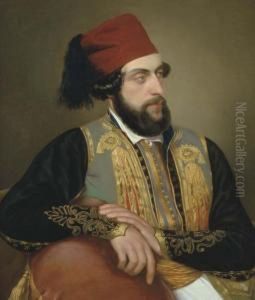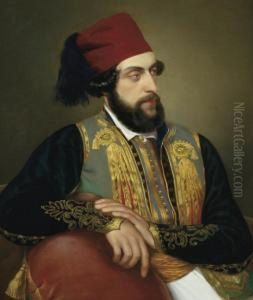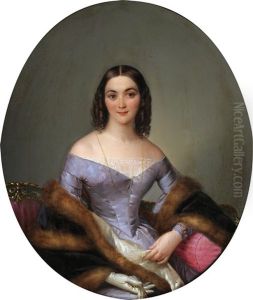Felice Schiavoni Paintings
Felice Schiavoni was an Italian painter born on November 28, 1803, in Nervesa della Battaglia, a town in the Veneto region of Italy. He was part of the 19th-century Italian painting tradition and is known for his historical and religious works, which reflect the Romantic style of the period.
Schiavoni's father was a modest painter, and his family was not particularly wealthy. Despite these humble beginnings, Schiavoni showed an early talent for art. His father provided him with his first lessons in drawing and painting, and recognizing his son's potential, he sent him to Venice to study. In Venice, Schiavoni enrolled in the Accademia di Belle Arti, where he was influenced by the works of the great Venetian masters.
During his education and subsequent career, Schiavoni was particularly influenced by the Nazarene movement, a group of early 19th-century Romantic painters who sought to revive the spirituality and simplicity of medieval and early Renaissance art. This influence is evident in many of Schiavoni's religious paintings, which emphasize narrative clarity, devoutness, and a return to traditional techniques.
In 1832, Schiavoni moved to Trieste, which at the time was a prosperous port city under the Austrian Empire. There, he became a central figure in the local art scene, receiving numerous commissions for portraits and religious works. His style was well-suited to the tastes of the middle-class and aristocratic patrons in Trieste, who appreciated his detailed and emotionally expressive paintings.
Schiavoni's works were exhibited in various cities, including Venice, Milan, and Florence, and he gained a reputation that extended beyond the borders of Italy. He was particularly adept at fresco painting, a skill that led to significant commissions for decorating public buildings and churches. Some of his notable works include frescoes in the Church of San Antonio Nuovo in Trieste and the Trieste Cathedral.
Despite his success, Schiavoni remained deeply connected to his roots, and his works often reflect a sense of nostalgia for his Venetian heritage. His paintings are characterized by a warm palette, attention to detail, and a romantic sensibility that captured the imaginations of his contemporaries.
Felice Schiavoni passed away on April 7, 1881, in Trieste. Although he is not as widely known today as some of his contemporaries, his contributions to 19th-century Italian art are recognized by art historians, particularly for his role in the cultural life of Trieste and the broader Veneto region. Schiavoni's works can be found in various museums and collections, where they continue to be appreciated for their historical and artistic value.














